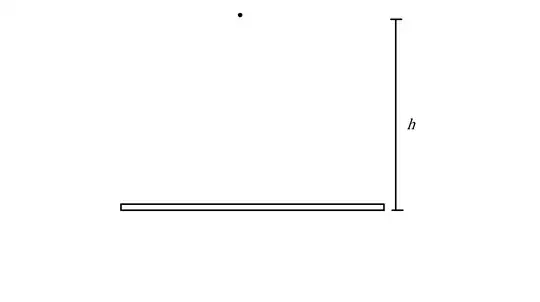This is a neat little problem. I don't think there's enough to go by to actually come up with a formula. We know too little about the glass itself. But I think we know enough to come up with a path forward for how one would go about it.
The first thing I'd like to do is a simplification. Let's take height out of the equation. Let's find the velocity of the hailstone that breaks the glass. This can easily be equated to height, but elides all discussion of drag and terminal velocities, and all that jazz.
Second simplification: lets assume the hailstone is frangible. If you have a very large hailstone (hail-bowling-ball?) it would plow through the glass like a frozen chicken through a windshield (thank you Mythbusters!). This could indeed be calculated, but I don't think its in the spirit of the question. The key assumption here is one of how long the impact takes versus the restoration period of the glass as it bounces back. If we assume the hailstone is small enough, it's reasonable to assume that it can't deflect the glass a very long distance before it breaks into a million pieces.
It's also possible that the hailstone could simply bounce off, but my gut instinct is that this is unlikely for hailstones that are large enough to do damage. So I'm going to assume that at impact, the hailstone breaks up and all of those pieces travel outward from the impact site, along the glass. This means that 100% of the momentum is transferred from the hailstone to the glass. Reality is probably more complicated. Backspray, bouncing off the windshield, could effectively cause more than 100% of the momentum to transfer (because the hailstone particles not only impart their forward momentum, but also have to have a backwards momentum afterwards. This means imparting even more momentum).
Frangibility also means that we can assume the forces are delivered conveniently to the glass. A frangible hailstone cannot concentrate all of its force on a very small point. It has to spread it out a bit. This has an interesting effect of causing the glass to not break on impact. Instead it breaks nearby, at a point where the strain to restore the glass's position exceeds the strength of the glass.
Is this a realistic assumption? From what I have seen, it is. This is exactly how glass cutters make both straight and curved lines. They weaken the glass along the line they care about, and then rap the glass near that line. The glass doesn't break at the point of impact. It breaks where it is weak. In addition, windshield repair companies have noted that a pre-existing crack in a windshield substantially increases the chance that a windshield will break on impact.
If you disagree with this assumption, then one should construct a local model of the glass near the impact site, and model the forces imparted by the hailstone. I won't do any calculations on this. If you agree with me, then the more interesting question becomes where the stresses caused by the impact get concentrated. This is a wave mechanics question. The impulse (perhaps modeled as a pulse with finite duration to account for the time it takes for the impact to occur) would excite the glass in the same way striking a drum with a drumstick does.
In theory one could mount the glass in an ideal-shaped structure which doesn't really concentrate the stresses. A circular window is a tempting first approximation (and the stresses would certainly involve Bessel functions). In practice, windows are held in different ways to accomplish goals other than maximizing hailstone defense, so there are likely to be points on the glass where more of the stress gets reflected to than others. Those would be the points that break first.
It may be difficult to compute the exact hailstone velocity which causes a break. Easier might be to take advantage of the step I skipped at the start: terminal velocity. Hailstones don't travel arbitrarily fast. They accelerate due to gravity until the drag forces on them match the force of gravity. This is their terminal velocity, and it would depend on the shape and mass of a hailstone. Assuming they are perfect spheres, it would thus depend on the radius of the hailstone. For any given radius, you can find a terminal velocity, and then plug it into your simulation of a glass pane to see what happens (I call it a simulation because it depends on so many measured aspects of the shape and makeup of the glass that it really has grow beyond a simple model. It also likely has to be done in a time-forward way, due to the complexities in coming up with analytical solutions for real windshield shapes). There should be a radius at which point the speed and mass is sufficient to break the windshield.
This would be the correct time to revisit my original assumption: can that sized hailstone locally break the glass fast enough that the wave-mechanics of the windshield don't really play a big part? I'd do some back of the envelope calculations, but this answer on drag shows that the relationship here is notoriously non-linear, so the calculations certainly would not fit on the back of an envelope.
